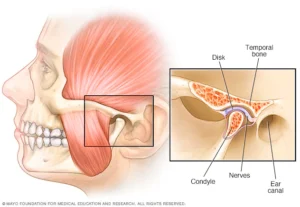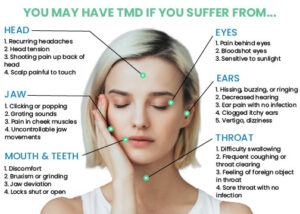TMJ / TMD (Temporomandibular Joint Disorder)

The temporomandibular joint (TMJ) acts like a sliding hinge, connecting your jawbone to your skull. You have one joint on each side of your jaw. TMJ disorders — a type of temporomandibular disorder or TMD — are 4 times more common in women than men and some type of them manifests in 1 out of 8 people. TMJ disorders can cause pain in your jaw joint and in the muscles that control jaw movement. Your pain may be due to a combination of factors, such as genetics, arthritis or jaw injury. Some people who have jaw pain also tend to clench or grind their teeth (bruxism), although many people habitually clench or grind their teeth and never develop TMJ disorders.
In most cases, the pain and discomfort associated with TMJ disorders are temporary and can be relieved with self-managed care or nonsurgical treatments.

Signs and symptoms of TMJ / TMD may include:
Pain or tenderness of your jaw; Pain in one or both of the temporomandibular joints; Aching pain in and around your ear; Difficulty chewing or pain while chewing; Aching facial pain; Locking of the joint, making it difficult to open or close your mouth. TMJ disorders can also cause a clicking sound or grating sensation when you open your mouth or chew. But if there’s no pain or limitation of movement associated with your jaw clicking, you probably don’t need treatment for a TMJ disorder. But if you suffer from persistent pain or tenderness in your jaw or if you cannot open and close your mouth properly, it is time to visit a doctor. Our specialists can offer treatments for fast and effective pain relief.
